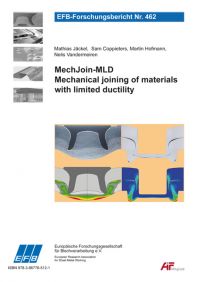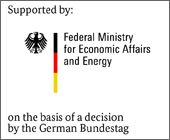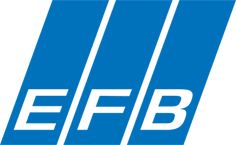MechJoin-MLD Mechanical joining of materials with limited ductility

(Mechanisches Fügen von Werkstoffen mit eingeschränkter Duktilität)
Verfasser:
Dr.-Ing. Mathias Jäckel, Fraunhofer-Institut für Werkzeugmaschinen und Umformtechnik Dresden - Dr.-Ing. Sam Coppieters, Faculteit Ingenieurswetenschappen, Katholieke Universiteit Leuven - Dr.-Ing. Martin Hofmann, Institut für Festkörpermechanik, Professur für Mechanik multifunktionaler Strukturen, Technische Universität Dresden - Ing. Nelis Vandermeiren, Belgisch Instituut voor Lastechniek vzw, Zwjinaarde
196 Seiten - 96,00 EUR (sw, 215 teils farbige Abb., 25 Tab.)
ISBN 978-3-86776-512-1
Abstract
Advanced lightweight materials, such as high strength aluminium and magnesium alloys, are used in an expanding range of engineering applications, such as in the transport sector, machine and equipment construction or the general construction industry. Thermal welding of these materials is, in contrast to steel, problematic since it severely affects both the static and fatigue resistance of the joint and the base material. This has strengthened the demand for more suitable joining techniques without heat input.
The focus of the present research is on the application of two of the most important conventional cold joining techniques (clinching and self-pierce riveting) for these new emerging lightweight materials. The challenge in this regard is that these materials have a limited ductility, while the joining processes locally induce large plastic deformations. Consequently, joining these materials can be accompanied by cracks which develop during the forming operation. This situation has limited the use of these materials and of the joining processes in the past.
The aim of the project was to develop rules and guidelines based on scientific results determining either how cracks induced by clinching or self-pierce riveting can be avoided or which cracks are acceptable. Therefore, the damage behaviour of lightweight materials, such as aluminium and magnesium, during the clinching and self-pierce riveting process was investigated both experimentally and numerically.
The results from the project can be summarized as follows:
Depending on the joining parameters and location in the component, different damages can occur during clinching or self-pierce riveting of materials with limited ductility. The relationships between joining parameters and the risk for damages in the closing head or part edge are demonstrated in this report and the risk for joining process-induced damages can be minimized by choosing the suitable joining tools.
For all material combinations considered within this project it could not be observed that the joining process-induced damages have a negative effect on the resulting joint strength. This was determined for quasi-static and cyclic loads for both clinching as well as self-pierce riveting.
In the numerical investigations regarding the damage modelling it was determined that the damage location as well as the level can be calculated by simple as well as complex fracture models. However, calculation of crack propagation in the die-sided part for clinching or self-pierce riveting using FEM is only possible to a limited extent.
The project "MechJoin-MLD Mechanical joining of materials with limited ductility" Ref.-No. AiF 125 EBR was supervised by the EFB. In the scope of the CORNET - European Research Programme "MechJoin-MLD" was funded by the German Federal Ministry for Economic Affairs and Energy via the Federation of Industrial Research Associations on the basis of a decision of the German Bundestag. The report is published as EFB-Forschungsbericht Nr. 462. |  |
Zusammenfassung
Ziel des Projektes war die Analyse von fügeprozessbedingten Schädigungen, welche beim Clinchen oder Halbhohlstanznieten von spröden Leichtbaumaterialien verursacht werden können. Dabei wurde das Schadensverhalten von Aluminium- und Magnesiumwerkstoffen während des Clinch- und Halbhohlstanznietprozesses sowohl experimentell als auch numerisch untersucht.
Die Ergebnisse des Projektes lassen sich wie folgt zusammenfassen:
Beim mechanischen Fügen für Materialien mit begrenzter Duktilität können radiale und tangentiale Risse im Schließkopf von Clinch- oder Halbhohlstanzniet je nach Materialkombination und Fügeparametern auftreten. Weiterhin besteht die Gefahr einer Rissbildung zwischen der Bauteilkante zum Fügepunkt. Die Zusammenhänge zwischen den Fügeparametern und dem Schadensrisiko im Schließkopf bzw. dem Bauteilrand werden in diesem Bericht demonstriert und dargestellt wie die Gefahr für die Bildung von prozessbedingten Schäden durch die Wahl der geeigneten Fügewerkzeuge reduziert werden kann.
Bei allen in diesem Projekt betrachteten Materialkombinationen konnte nicht nachgewiesen werden, dass die fügeprozessbedingten Schäden im Schließkopf einen negativen Einfluss auf die resultierende Verbindungsfestigkeiten haben. Dies wurde anhand quasistatischer und zyklischer Festigkeitstests für das elementare und hybride Clinchen und Halbhohlstanznieten untersucht.
Bei den numerischen Untersuchungen zur Schadensmodellierung wurde festgestellt, dass der Schadensort sowie das Niveau durch einfache Schadensmodelle wie dem nach Cockroft & Latham sowie komplexe Bruchmodelle wie dem nach Bai & Wierzbicki berechnet werden können. Allerdings ist die Berechnung der Rissausbreitung im matrizenseitigen Bauteil beim Clinchen oder Halbhohlstanznieten mittels FEM-Simulation nur in begrenztem Umfang möglich. Die notwendige Elementlöschung führt zu Verzerrungen im Netz, die oft zu einem Abbruch der Simulation führen.
Das „crack tip opening displacement concept" ist nicht für die Analyse von Rissen beim mechansichen Fügen geeignet, da die Risse im gleichen Größenbereich liegen wie die kritische Rissspitzenöffnungsverschiebung und diese Risse mindestens um ein Vielfaches größer sein müssen.
Kaltverschweißeffekte konnten beim Halbhohlstanznieten von Aluminiumdruckguss beobachtet werden, aber nicht für den Magnesiumdruckguss. Mit den durchgeführten Experimenten war es nicht möglich, die Festigkeit solcher Kaltschweißungen zu bewerten.
Hinsichtlich geeigneter Methoden zur Qualitätsbewertung von fügeprozessbedingten Rissen zeigen Thermografie und Computertomographie das größte Potenzial in Bezug auf die Erkennung der Risse sowohl innerhalb als auch auf der Oberfläche der Clinch- oder Halbhohlstanznietverbindungen.
Das Projektziel wurde erreicht.
Table of contents
Abstract
List of formula symbols and abbreviations
Formula Symbols
Abbreviations
List of figures
List of tables
1 Introduction
2 State of the art
2.1 Self-pierce riveting
2.2 Clinching
2.3 Damage modelling for mechanical joining
2.3.1 Self-pierce riveting
2.3.2 Clinching
2.3.3 Mechanical damage models
2.3.4 Crack tip opening displacement concept for clinching
3 Problem and research objective
3.1 Problem statement
3.2 Research objectives
4 Materials, equipment and tools
4.1 Investigated materials
4.2 Joining equipment
4.2.1 Self-pierce riveting (IWU)
4.2.2 Clinching (KUL)
4.3 Joining elements and tools
4.3.1 Self-pierce riveting (IWU)
4.3.2 Clinch forming (KUL)
5 Simulation models
5.1 Self-pierce riveting
5.1.1 FE models (IWU/TUD)
5.1.2 Strain hardening behaviour (IWU)
5.1.3 Calibration of the Bai-Wierzbicki damage model (TUD)
5.2 Clinching
5.2.1 FE models
5.2.2 Strain hardening behaviour (KUL)
5.2.3 Calibration of the used damage models (KUL)
6 Experimental joint analysis
6.1 Elementary and hybrid self-pierce riveting (IWU)
6.1.1 Aluminum die-casting
6.1.2 Magnesium die-casting
6.2 Elementary and hybrid clinching (BWI)
6.2.1 Scanning electron microscopy
6.2.2 Metallographic examination
6.2.3 Joining parameters
7 Joint strength tests
7.1 Elementary and hybrid self-pierce riveting (IWU)
7.1.1 Testing methods
7.1.2 Material combination with aluminum die-casting
7.1.3 Material combination with magnesium die-casting
7.2 Elementary and hybrid clinching (BWI, KUL)
7.2.1 Testing methods
7.2.2 Quasi-static strength of elementary clinching
7.2.3 Quasi-static strength of hybrid clinched joints
7.2.4 Fatigue behaviour of clinched joints
8 Numerical process analysis
8.1 Self-pierce riveting of aluminum die-casting
8.1.1 Process analysis and simple damage modelling (IWU)
8.1.2 Sensitivity analysis (IWU)
8.1.3 Advanced damage modelling (TUD)
8.1.4 Loading simulation (TUD)
8.2 Self-pierce riveting of magnesium die-casting
8.2.1 Process analysis and simple damage modelling (IWU)
8.2.2 Advanced damage modelling (TUD)
8.3 Clinching of high strength aluminum sheets
8.3.1 3D model for clinching without damage (TUD)
8.3.2 Comparison of damage models by 2D simulation (KUL)
8.3.3 Comparison of damage models by 3D simulation (KUL)
8.3.4 Loading simulation (KUL)
9 Fracture mechanic analysis (TUD)
9.1 Determination of critical crack tip opening displacement
9.2 Crack closure at self-pierce riveting
9.3 Numerical assessment of existing cracks at clinching
10 Concepts for quality assurance (BWI)
10.1 Visual inspection
10.2 Colour penetrant testing
10.3 Fluorescent penetrant testing
10.4 Induction thermography
10.5 Active thermography
10.6 Conventional radiography
10.7 Computed radiography
10.8 Computer tomography
10.9 Conclusion
11 Summary
List of Literature

